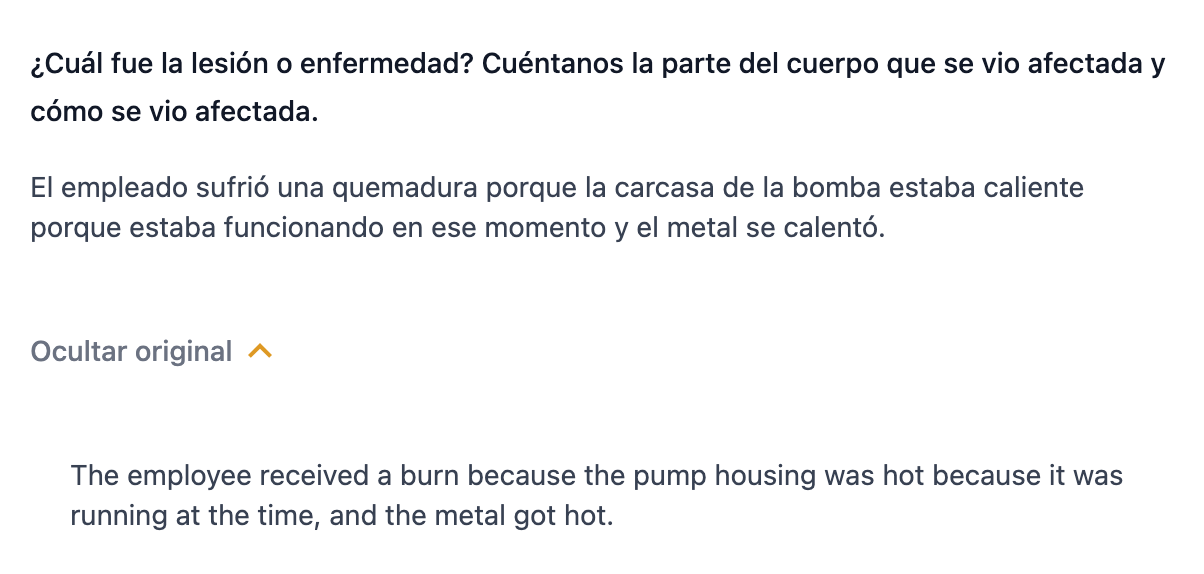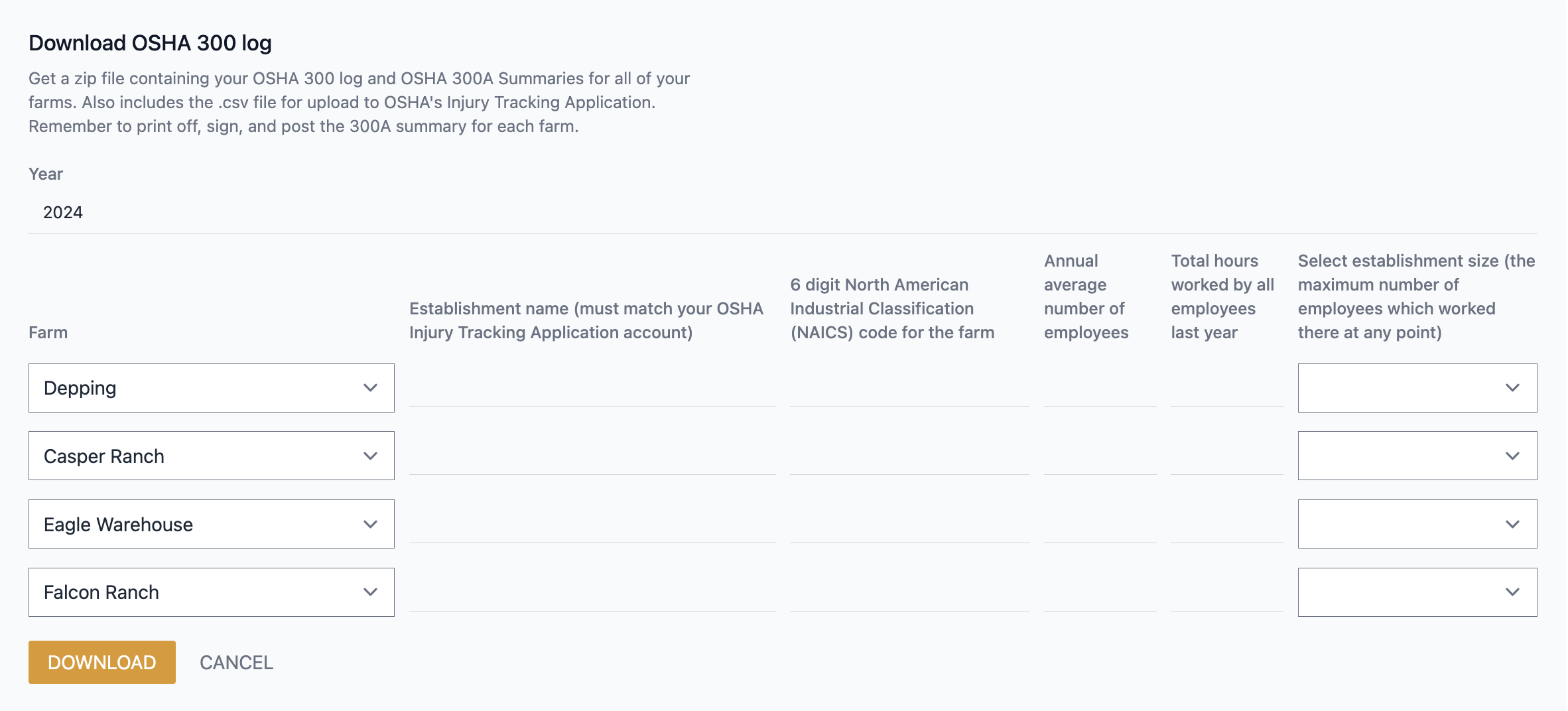I've reviewed numerous accident reports and heard many horror stories of what came next. That's why we built an accident log into Harvust, to prevent more horror stories, save time, and increase compliance. Here are the top mistakes I identified, along with the solutions we've built to address them for you.
1. Failing to Record a Recordable Incident
The problem:
One major mistake is failing to log an injury or illness that meets OSHA's recordable criteria. Unfortunately, the requirements are hundreds of words long with many carve-outs. No farm manager does or should have those memorized!
Why it matters:
Misclassifying a serious case as non-recordable (or simply neglecting to record it) is a record-keeping violation. For example, OSHA fined multiple facilities (including large warehouses) for incorrectly classifying injuries and illnesses, since underreporting conceals workplace hazards. Failing to record any qualifying injury in farming operations not only violates OSHA rules but can also undermine workers' compensation claims or defenses in a lawsuit, as there will be no official record of the incident.
How Harvust solves this:
When you create an accident report in Harvust, the system automatically scans the report details and determines if it meets the OSHA criteria. It saves this determination and automatically enriches the report with other OSHA requirements like a case number, and information about the report author.

2. Misclassifying the Severity
The problem:
HR managers often struggle with how to classify an injury/illness on the OSHA forms. A common error is checking multiple classification boxes on the OSHA 300 Log for one injury – for instance, marking both "days away from work" and "job transfer/restriction" for the same case. OSHA instructs ag employers to check only one most-severe outcome category per case (e.g., if a farmworker missed days and then had restricted duty, you check the "days away" box only). Checking two boxes makes it appear as though there are two separate incidents when tallying totals, skewing your injury rates.
Why it matters:
Using the wrong classification can result in record-keeping citations and mislead you about the true causes (acute injury vs. chronic illness) affecting workers.
How Harvust solves this:
The Harvust accident log only allows you to select one classification at a time. It conditionally displays any related (but required) fields, such as "date of death" or "number of days away from work".
3. Misclassifying the Nature of the Case
The problem:
Likewise, misidentifying the nature of the case is an issue, for example, labeling a work-related illness as an injury. In agriculture, conditions such as farmer's lung, heat stroke, or pesticide poisoning should be logged as "illnesses" rather than injuries, but HR might mistakenly lump everything together as an injury. OSHA expects cumulative or gradual-onset conditions (e.g., hearing loss from loud farm equipment, repetitive stress injuries, sunstroke) to be categorized as illnesses on the log.
Why it matters:
Using the wrong classification can result in record-keeping citations and mislead you about the true causes (acute injury vs. chronic illness) affecting workers.
How Harvust solves this:
As you fill out the accident description and affliction details on Harvust, the system will use AI to compare it to the official OSHA guidelines on injury/illness classification and select the appropriate one on your behalf.
4. Inaccurate Incident Details
The problem:
Quality of documentation matters. Transposed dates, incorrect names or body parts, or misreading handwritten notes can all occur, especially in farming, where mayordomos scribble initial reports in Spanish in the field, which are then (mis)transcribed in the office and eventually mistranslated.
Why it matters:
A lack of detail can create liability issues later; if the report doesn't clearly explain the cause, an investigator might assume the worst-case scenario. An inaccurate report can undermine your defense or complicate workers' comp if the facts don't line up. Such errors not only violate OSHA's requirement for accurate record-keeping (and can incur fines even if unintentional), but they also misrepresent the conditions of the injury to both OSHA and your own farm.
How Harvust solves this:
The Harvust accident log is user-friendly, enforces correct formatting, validates required fields, and auto-translates from Spanish to English eliminating spelling and transcription errors.

5. Missing OSHA Reporting Deadlines
The problem:
Timing is critical in OSHA injury reporting, and HR managers sometimes miss key deadlines. OSHA has immediate notification requirements for severe incidents: a work-related fatality must be reported to OSHA within 8 hours, and any inpatient hospitalization, amputation, or loss of an eye must be reported within 24 hours. Additionally, at year's end, the annual summary (Form 300A) must be compiled and posted at the workplace from February 1 to April 30, and then electronically submitted to OSHA.
Why it matters:
Failing to promptly call OSHA or submit an online report for these severe cases can trigger hefty penalties. (Note: This requirement applies even in agriculture, although small farm exemptions might limit OSHA's jurisdiction; if in doubt, report it.) Beyond fines, late reporting appears unfavorable if an OSHA inspection or lawsuit occurs, as it suggests the farm isn't proactive or transparent about injuries.
How Harvust solves it
Harvust automatically sends email notifications to your farm's safety managers when a fatality or serious injury is logged, alerting them of the critical deadlines. Harvust also sends you an email at the beginning of every year with a link to download your OSHA 300/A documents and export for upload to OSHA's website.
6. Failure to Retain Records
The problem:
Another mistake is not properly maintaining injury records for the required period. OSHA requires that farms keep their injury/illness records (OSHA 300 logs, 301 reports, and 300A summaries) on file for at least five years after the end of the year those records cover.
Why it matters:
Not having the past 5 years of records readily available during an OSHA inspection is a citable offense. Likewise, failing to produce documents if a former employee or their representative requests them can violate OSHA's access rules. From a liability standpoint, poor record retention can harm your company in court; if you cannot show consistent injury logs or safety improvements over time, it may appear as negligence.
How Harvust solves this:
Harvust retains all records on your behalf forever. You can download all accident reports and OSHA 300/A files at any time in just a few minutes - meeting the readily available requirement.

7. Assuming OSHA Rules Don't Apply (Small Farm Exemption Misuse)
The problem:
A mistake especially relevant to family farms is assuming that your operation is exempt from OSHA injury reporting when it's not. Very small employers are indeed partially exempt from routine OSHA record-keeping. If you had 10 or fewer employees at all times in the previous calendar year, you generally do not have to keep OSHA 300/301 logs for the current year. However, many farm owners misinterpret this. The threshold is based on peak employment of the entire company, not the average number. If at any point last year you had 11 or more workers (including part-timers and seasonal hires), you lose the small employer exemption.
Why it matters:
Believing that "OSHA can't touch us" can lead to complacency in reporting. You must still report fatalities or serious incidents to OSHA promptly. The liability risk here is significant: if a serious accident occurs and it is discovered that the farm kept no injury records, OSHA could issue citations for each unlogged injury and for failing to report a significant incident. In a post-accident lawsuit, the absence of proper documentation can be used to demonstrate negligence or a lack of safety oversight.
How Harvust solves this:
While Harvust tracks whether OSHA record-keeping rules apply to your farm, it always errs on the side of keeping a log of all injuries. Harvust makes it fast and easy to log an accident. By making it less work to report, it's more likely you'll actually do it.
Are you struggling with injury reporting? Get in touch with us to see if Harvust is the right solution for you!





